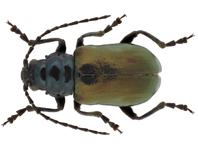Abstract
Pygicera Kerremans, 1903 is an endemic genus of jewel beetle of Chile distributed in the central Chile hotspot, which is distributed from the Atacama Desert in the north to the Valdivian Forest in the south (Myers et al., 2000). Currently, Pygicera is composed of one species and two subspecies: Pygicera scripta scripta Laporte & Gory, 1837 and the Valdivian rainforest subspecies Pygicera scripta krahmeri Moore 1981 (Figs 2–6). The first subspecies is distributed from Limarí in the Coquimbo Region to Curicó in the Maule Region, both in the coast as well as Andean foothills. This is considered the common subspecies (Moore, 1981; Moore & Vidal, 2015). The southern subspecies is distributed from Victoria in the Araucanía Region to La Unión in Los Ríos Region (Moore, 1981; Moore & Vidal, 2015) and is the rarest and less abundant subspecies. The larvae of both subspecies have been recorded in the “maitén” (Maytenus boaria) Molina, from which they have been reared (Moore, 1981, 1987; Moore & Vidal, 2015).
References
Fuentes, G., Cisternas, A., Valencia, G., Mihoc, M., Ruiz, E., Hasbún, R., Valenzuela, S. & Baeza, C.M. (2017) Diversidad taxonómica y genética del sitio prioritario Península de Hualpén, Región del Bío-Bío, Chile. Implicancias para la conservación. Gayana Botánica, 74 (1), 94–110.
https://doi.org/10.4067/S0717-66432017005000112
Gajardo, R. (1994) La vegetación natural de Chile. Clasificación y distribución geográfica. Editorial Universitaria, Santiago, 165 pp.
Goloboff, P.A. (1995) A revision of the South American spiders of the family Nemesiidae (Araneae, Mygalomorphae). Part 1, Species from Peru, Chile, Argentina, and Uruguay. Bulletin of the American Museum of Natural History, 224, 1–189.
Grez, A.A. (2005) The importance of small fragments of Maulino forest for the conservation of epigeous beetles. In: Smith-Ramirez, C., Armesto, J.J. & Valdovinos, C. (Eds.), Historia, biodiversidad y ecología de los bosques costeros de Chile. Editorial Universitaria, Santiago de Chile, 565–572.
Lara, A., Solari, M.E., Prieto, M.D.R. & Peña, M.P. (2012) Reconstrucción de la cobertura de la vegetación y uso del suelo hacia 1550 y sus cambios a 2007 en la ecorregión de los bosques valdivianos lluviosos de Chile (35º-43º 30 S). Bosque, Valdivia, 33 (1), 13–23.
https://doi.org/10.4067/S0717-92002012000100002
MMA (2018) Especies: Clasificación según estado de conservación. Availabe from: http://www.mma.gob.cl/clasificacionespecies/listado_especies_15o.htm (accessed 25 November 2018)
Moore, T. (1981) Aporte al conocimiento de los Bupréstidos en Chile. Revista Chilena de Entomología, 11, 37–68.
Moore, T. (1987) Aporte al conocimiento de los Bupréstidos de Chile. Cuarta contribución. Revista Chilena de Entomología, 15, 13–19.
Moore, T. & Vidal, P. (2015) Los Bupréstidos de Chile. Ediciones Universidad Católica de Chile, Santiago, 398 pp.
Myers, N., Mittermeier, R., Mittermeier, C., Fonseca, G. & Kent, J. (2000) Biodiversity hotspots for conservation priorities. Nature, 403, 853–858.
https://doi.org/10.1038/35002501
Pauchard, A., Aguayo, M., Peña, E. & Urrutia, R. (2006) Multiple effects of urbanization on the biodiversity of developing countries: the case of a fast-growing metropolitan area (Concepción, Chile). Biological conservation, 127 (3), 272–281.
https://doi.org/10.1016/j.biocon.2005.05.015
Polymeris, C. (1995) Vegetación actual de la Península de Hualpén. Clasificación y dinámica. MsC dissertation, Universidad de Concepción, Concepción, 190 pp.
Rojas, C., Pino, J., Basnou, C. & Vivanco, M. (2013) Assessing land-use and-cover changes in relation to geographic factors and urban planning in the metropolitan area of Concepción (Chile). Implications for biodiversity conservation. Applied Geography, 39, 93–103.
https://doi.org/10.1016/j.apgeog.2012.12.007
Teneb, E.A., Cavieres, L.A., Parra, M.J. & Marticorena, A. (2004) Patrones geográficos y de distribución de árboles y arbustos en la zona de transición climática mediterráneo-templada de Chile. Revista Chilena de Historia Natural, 77 (1), 51–71.
https://doi.org/10.4067/S0716-078X2004000100006
Vargas-Almonacid, P. & Stuardo, J.R. (2007) Two new genera of land snails (Stylommatophora: Arionacea) from Chile. Revista de Biologia Tropical, 55 (2), 693–708.
https://doi.org/10.15517/rbt.v55i2.6046
Vera, A. (2010) Estudio taxonómico del género monotípico Aphractus (Orthoptera: Tettigoniidae, Pseudophyllinae). Revista de la Sociedad Entomológica Argentina, 69, 253–260.
Vergara, O.E., Jerez, V. & Parra, L.E. (2006) Diversidad y patrones de distribución de coleópteros en la Región del Biobío, Chile: una aproximación preliminar para la conservación de la diversidad. Revista Chilena de Historia Natural, 79 (3), 369–388.
https://doi.org/10.4067/S0716-078X2006000300008
Zamora-Manzur, C., Parra, L.E. & Jaque, E. (2011) Patrones de distribución de los geométridos de la Región del Biobío, Chile: Una aproximación para su conservación. Revista Chilena de Historia Natural, 84 (4), 465–480.

